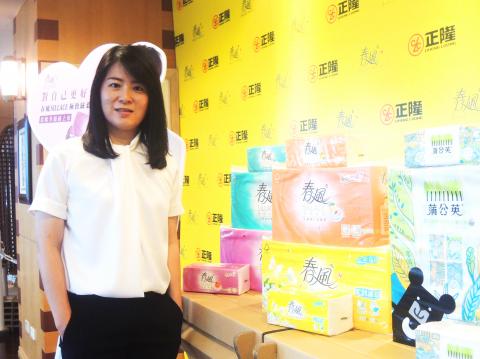In Taiwan, which variety of toilet paper currently sells the best? The answer may not be the one you were expecting. Household sanitary paper manufacturers have this year discovered that 3-ply toilet tissue has emerged as a force to be reckoned with within the market, with sales volumes jumping 20 percent. Toilet tissue impregnated with balsam and forest-friendly, recycled alternatives have all exhibited strong sales performance. The industry is speculating that Taiwan is gradually moving toward becoming an M-shaped society, as consumer purchasing power becomes more polarized.
Household sanitary paper manufacturers have discovered that 3-ply loo paper is selling like hot cakes. For example, for US wholesaler Costco, in addition to its own-brand Kirkland toilet paper, other 3-ply offerings from Kleenex and established brand May Flower, have all been selling well. According to papermaking conglomerate YFY, although 2-ply toilet paper still constitutes the bulk of the market, sales volumes of 3-ply have been gradually increasing, with some lines becoming best-sellers. Papermakers are now rushing to ramp up production and supply of 3-ply.
According to YFY, in 2016 sales revenue for 3-ply toilet paper totalled NT$870 million but broke the NT$1billion mark last year: a year-on-year increase of nearly 19 percent and 16 percent market share.

Photo: Lee Ching-hui, Liberty Times
照片:自由時報記者李靚慧
This year, YFY launched a premium 3-ply version of its flagship May Flower toilet paper to appeal to consumers who demand a superior quality feel and softness. Cheng Loong Corp, which markets a top-of-the-range 3-ply extra-thick, 50-percent-more-absorbent toilet paper under the Andante brand, has seen a 20 percent increase in sales of the product since the beginning of this year.
As for the cause of mushrooming sales of 3-ply toilet paper, the industry believes Taiwan’s consumer market is becoming “M-shaped.” Although many Taiwanese consumers still count every penny, consumers on the right lobe of the “M” curve attach a greater degree of importance to quality, the environment and functionality, and are willing to fork out more cash to buy products perceived to be of a higher quality.
(Liberty Times, translated by Edward Jones)
在台灣,現在哪一種衛生紙最好賣?答案可能跌破不少人眼鏡。家用紙業者發現,今年以來價格較高的三層衛生紙異軍突起,銷售量大增二成;添加乳霜的衛生紙、不砍樹的再生紙衛生紙,也都有不錯的銷售成績。業者推測,應與台灣走向M型社會,消費力逐漸兩極化有關。
家紙業者發現,「三層衛生紙超好賣」,以美式賣場好市多為例,除了自有品牌Kirkland外,目前銷售的舒潔以及先前銷售的五月花都相當受歡迎,這些都是「三層衛生紙」。永豐餘控股指出,雖然目前二層衛生紙仍是市場主流,但三層衛生紙的銷售額逐年成長,部分通路甚至是「三層衛生紙最好賣」,因此紙廠會儘可能將產能供應三層衛生紙。
永豐餘指出,二○一六年台灣市場三層衛生紙銷售金額僅八.七億元,二○一七年已突破十億元,年增近百分之十九,且在衛生紙產品的占比提升至百分之十六。
永豐餘今年就主打旗下「五月花」三層衛生紙,訴求高質感、柔軟的特性。正隆的「春風」三層衛生紙,則主打「三層厚手、吸水力提升百分之五十」,今年以來銷售量大增二成。
對於三層衛生紙銷售成長的主因,業者認為,台灣的消費市場出現M型化趨勢,雖然有不少消費者仍對價格錙銖必較,但在M型右方的消費者更重視品質、環保、功能等,願意花較多的錢買品質更好的產品。
(自由時報記者李靚慧)
Follow up讀後練習
M-shaped Society
The M-shaped Society is a term originally coined by the Japanese economist Kenichi Ohmae. Ohmae observed that Japanese society had become polarized into the extreme rich and the extreme poor, with a shrinking middle class caught in between, in what he termed an “M-shaped” distribution.
In a “normal” distribution pattern in a developed, modern society, the middle class generally forms the bulk of the society.
With the emergence of the M-shaped society, however, this middle class is much reduced, being assimilated into the two lobes of the M-shape either side of it, and gradually disappears. As a result of this process, the middle class no longer forms the bulk of the society.
Another feature of the M-shaped society, and one which contributes to the maintenance of the shape, is the difficulty for people in the middle class to ascend the social ladder and join the upper class. Most of them will gradually sink to the lower-income group.
(Edward Jones, Taipei Times)

A: According to reporter Joon Lee’s analysis, what are other reasons why the Los Angeles Dodgers made back baseball superstar Shohei Ohtani’s huge contract so quickly? B: Second, a lot of Japanese and global enterprises are eager to benefit from the “Ohtani effect”. . . A: That’s sure to increase the Dodgers’ bargaining chips in negotiations. B: Lastly, all this media coverage is elevating the Dodgers’ brand to a new level, boosting the value of the franchise. A: I can’t wait to see a battle between Ohtani and “Team Taiwan” at the 2026 World Baseball Classic. A: 根據記者Joon Lee的分析,洛杉磯道奇隊和球星大谷翔平的巨約快速回本還有哪些原因? B: 第二、無數日本和全球企業都想和這股「大谷效應」沾上邊……。 A: 這也增加了道奇在各種商業談判中的籌碼吧。 B: 第三、媒體報導更將道奇的品牌形象推升至全新的高度,使該隊價值水漲船高。 A: 真期待在2026年「世界棒球經典賽」,看到大谷和台灣隊的經典對決! (By Eddy

The subject of placebos has been fascinating scientists and medical professionals for decades. The word placebo comes from Latin and means “I shall please.” The concept of the placebo effect refers to the phenomenon in which treatments or procedures produce positive outcomes merely because individuals believe they will work. __1__ During medicine trials, researchers often include a “placebo group” as a control to measure the true efficacy of the medication being tested. While one group receives actual drugs, the placebo group is given an inert substance, such as a sugar pill. To ensure unbiased results, participants in the placebo

With the pace of climate change speeding up, extreme weather and other impacts are taking an increasing toll on populations and environments across the globe. Here are some of the developments this year in climate science: WARMER, FASTER Global temperatures are not just climbing, they are now climbing faster than before, with new records logged for 2023 and 2024, and at points in 2025. That finding was part of a key study in June that updated baseline data used in the science reports done every few years by the Intergovernmental Panel on Climate Change. The new research shows the average global

1. 他們搭船渡河。 ˇ They crossed the river by boat. χ They crossed the river by the boat. 註︰ 表示交通方式時,交通工具前不加冠詞,如 by car、by train、by bus、by plane、by ship 等。若加了冠詞,則變成特指,意思是「他們搭上了正談論的那班船」,而不是泛指搭船這種交通方式。 2. 他們不再相信社會主 ˇ They no longer believe in socialism. χ They no longer believe in the socialism. 註︰ socialism、capitalism 等以 -ism 結尾的抽象名詞前不加冠詞。 3. 王博士演講介紹量子力學的基本知識。 ˇ Dr. Wang gave a lecture on the basics of quantum mechanics. χ Dr. Wang gave a lecture on the basics of the quantum mechanics. 註︰ 「量子力學」作為一種科目,不需加定冠詞。其他如 political science、Chinese literature、English history 等也是如此。 4. 南方人喜歡吃米,不太吃饅頭。 ˇ The southerners prefer rice to steamed bread. χ The southerners prefer the rice to the steamed bread. 註︰ rice、flour 等物質名稱前面不加冠詞。 5. 他因該戰役的功績晉升為上校。 ˇ He was promoted to the rank of colonel because